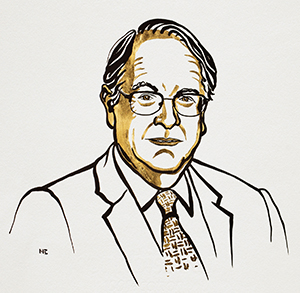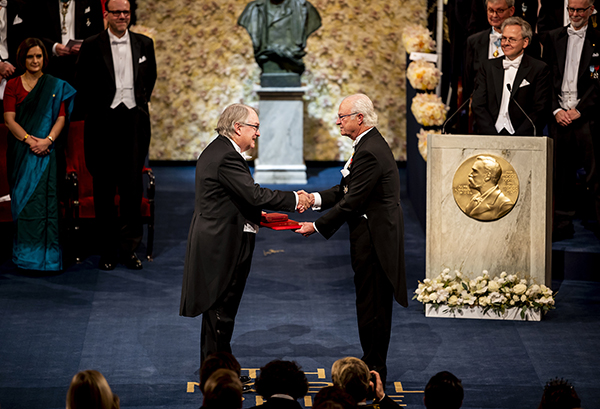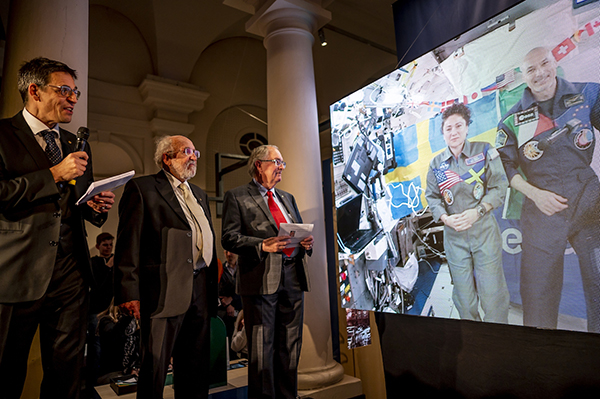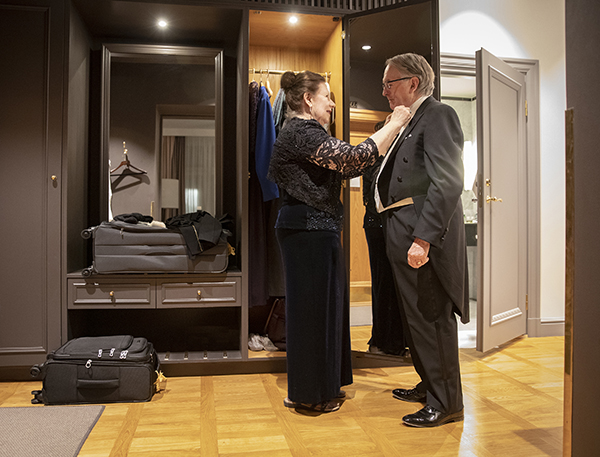The Nobel journey of M. Stanley Whittingham
Distinguished professor earns chemistry prize for lithium-ion battery development
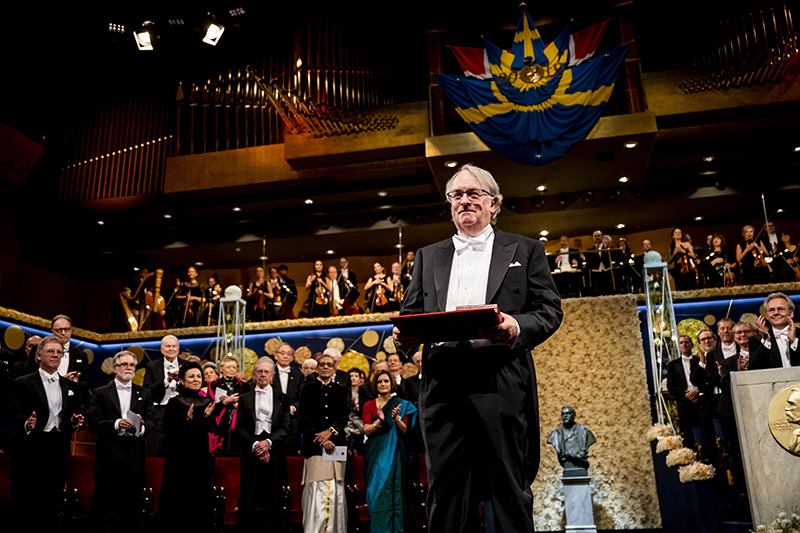
M. Stanley Whittingham was attending a scientific conference in Germany when the news reached him: You are a Nobel laureate.
The Binghamton University chemist had delivered the keynote address that morning. During a break in the meeting, one of the conference organizers told him someone was trying to reach him. She said they were going to call her phone and she’d hand it to him.
The call was from two members of the Nobel committee. And they had life-changing news for Whittingham: He and two other pioneers in the development of the lithium-ion battery — Akira Yoshino and John B. Goodenough — would share in the 2019 Nobel Prize for Chemistry.
“A number of things clicked,” says Whittingham, whose colleague later asked why he didn’t seem more jubilant. “I was probably in shock, and I smiled later.”
Next Whittingham tried calling home. It was Oct. 9 and his wife, who’s Jewish, had turned off her phone for Yom Kippur observances. He sent texts to his son and daughter after that. It turned out that one of his four grandkids had already heard the news.
It was the beginning of an adventure more than 40 years in the making.
Whittingham, now 78, invented the first rechargeable lithium-ion battery in 1977 at Exxon Research and Engineering Co. Although he worked alongside Nobel winners there, he didn’t consider the possibility he’d one day join their ranks.
“When you’re 30 years old,” he says, “you don’t really think about Nobel prizes.”
Decades later, however, the prize was very much on the minds of many at Binghamton University. In 2015, Thomson Reuters named Whittingham to a list of likely future laureates, noting the significance of his work on the lithium-ion battery.
That fall, the campus communications office was on alert during the Nobel announcements. But when years passed without a prize for Whittingham, that sense of anticipation lessened. By 2019, the news caught Binghamton by surprise.
***
In December, Whittingham traveled to Sweden for a week of events that included the presentation of the Nobel prizes. He was joined by his wife, their children and grandchildren, other relatives and a small number of Binghamton colleagues. President Harvey Stenger, university photographer Jonathan Cohen and Whittingham’s longtime assistant, Elaine Schmitz, were on hand for some of the festivities.
Stenger was struck by the way Whittingham was received during a program at the home of Judith Gough, the British ambassador to Sweden. The event honored Whittingham and Sir Peter J. Ratcliffe, a British physician-scientist who shared in the 2019 Nobel Prize in Physiology or Medicine. Gough had two electric vehicles — a Jaguar and a London city taxicab — on hand for the occasion.
“Stan was introduced by the British ambassador,” Stenger says. “She just gushed over him. She was so excited about his work.”
Whittingham was one of three laureates chosen to speak via satellite with astronauts on the International Space Station. Lithium-ion batteries had been installed on the station within the past month, so they had a lot to talk about, he says.
He also enjoyed talking to a couple of the Swedish princesses during some of the formal meals that were held in honor of the laureates.
The week was packed with activities and receptions, but Whittingham did do a little bit of sight-seeing. He went to Abba The Museum (No. 4 on TripAdvisor’s list of things to do in Stockholm) as well as to the Vasa Museum nearby (No. 1). The Vasa, a warship that sank on her maiden voyage in the 17th century, was salvaged some 300 years later.
“The experience that I had with him in Stockholm was probably one of the highlights of my life,” Stenger says. “It was fun. It was exciting. The different ceremonies were impressive.”
The award ceremony itself was quite staid and scripted, with men in tuxedos and women in gowns. All of the participants — except Swedish King Carl XVI Gustaf, who has been presenting the prizes since 1973 — rehearsed their roles in advance.
Carl-Henrik Heldin, chairman of the Board of Directors of the Nobel Foundation, opened the ceremony with remarks in English about the value of science and scientific progress, including a quote from Carl Sagan: “There are many hypotheses in science which are wrong. That’s perfectly all right: it’s the aperture to finding out what’s right. Science is a self-correcting process.”
Afterward, some 1,300 people, including the king and queen of Sweden, attended a formal banquet at city hall for a three-course meal.
Stenger, who has attended his fair share of fancy occasions as a university president, described the scene as “unbelievable.” The menu featured caviar, stuffed duck and several desserts. “I can’t imagine anything being more elaborate than this banquet,” Stenger says. He heard there were 50 chefs and 350 waiters on hand for the occasion.
Whittingham and his wife were seated at the king and queen’s table. One person representing each prize gets to speak, and Whittingham represented his colleagues.
He took the opportunity to celebrate innovation across the world: “This prize also reinforces that science is truly an international endeavor involving most of the countries in this world,” he remarked. “I am an Englishman in America. John Goodenough, an American, made his inventions in England. Akira Yoshino was in Japan. Science knows no geographical boundaries.”
Stenger says Whittingham was the only speaker who addressed the human dimension of his work, not just the research itself. “He was so humble,” Stenger says. “It was a great speech with just a perfect message.”
Whittingham, who sometimes used to wonder if his research was “too applied” to attract the notice of the Nobel committee, now says he thinks the invention fits Alfred Nobel’s original plan for the prizes quite well. Nobel specified in his will that the bulk of his fortune should be used for prizes in physics, chemistry, physiology or medicine, literature and peace to those who “have conferred the greatest benefit to humankind.”
Everyone can relate to batteries, Whittingham says, and maybe even understand them a little. After all, these days almost everyone is walking around with lithium-ion batteries in their cellphones and laptops.
Now he says he prefers to describe his work as “focused” research. “There’s some goal in mind; it’s not just research for its own sake,” Whittingham says. “I like to feel it makes a difference.”
While Whittingham was in Sweden, the BBC broadcast a program called “Nobel Minds Debate.” He represented the chemistry laureates for the discussion. When moderator Zeinab Badawi described the invention of the lithium-ion battery, she didn’t hold back: “This provided stable, lightweight, renewable energy storage, helping to create the right conditions for a wireless world free of fossil fuels. The world’s most powerful battery.”
***
Whittingham was born in Nottingham, England, and attended school in Lincolnshire before going to New College, Oxford, where he did his undergraduate and graduate work in chemistry.
Whittingham’s father, a civil engineer, was the first in his family to go to college. Since then, relatives have embraced the sciences: Whittingham’s brother is also a chemist, and a niece earned her doctorate in materials science from Cambridge.
When he completed his degree at Oxford, Whittingham came to the United States for a postdoctoral fellowship at Stanford University.
“I wanted to see the world,” he recalls. “I wanted to see the sunshine. There was an opportunity in California, and I grabbed it!”
Several scientists from his former group at Oxford have gone on to do work at Stanford in the decades since. “It’s not a bad pedigree,” Whittingham says with a small smile.
After he completed his postdoctoral studies, Whittingham went to work at Exxon. This was before the oil crisis, he notes, and Exxon aspired to be the best energy company in the world, with investments in research related to renewable energy as well as oil.
The battery Whittingham and his team developed at Exxon was smaller than other rechargeable batteries of the day (lead-acid cells like the ones still found in many cars) and unlike smaller, disposable batteries (the kind you probably still use in your TV remote), it could be recharged.
The critical discovery? As Exxon explains: That when lithium ions were held between plates of titanium sulfide, the ions could move back and forth between the positive and negative contacts, creating electricity. Whittingham was the first to find a way to use lithium to store energy at room temperature and without the risk of explosion.
Later, Goodenough built on Whittingham’s work to use metal oxides and higher, 4-volt materials. Yoshino expanded on that work, providing a safe carbon anode to replace lithium metal and developing the first commercial lithium-ion battery.
The key word in describing this chemistry is “intercalation,” Whittingham says. The word used to refer to putting Feb. 29 into the calendar every fourth year and taking it back out. In chemical terms, it means putting lithium ions into a structure without changing the structure itself.
Think of it like adding a layer of jam between two pieces of bread. “The lithium is the jam in the sandwich,” Whittingham says, and the bread isn’t changed.
***
Several years later, Whittingham — by then at Schlumberger-Doll Research — decided he was going to leave industry.
The opportunity to be a mentor and to work with scientists at all different stages of their careers appealed to him. “In companies, you all age together,” he says. “In a university, you get a new group of 18-year-olds in each year. It keeps you younger.”
He spoke to people at several schools, including campuses that were looking for department chairs. “What’s special at Binghamton is that there are no barriers between the departments,” he says. “You can interact with geologists, physicists, engineers with no issues. At many major schools, you have fiefdoms.”
Another big plus? Greater Binghamton’s reasonable commute times. Whittingham wanted to be able to live in the country and drive to work in five or 10 minutes.
At Binghamton, Whittingham has continued to thrive. He helped to establish the Materials Science and Engineering Program, built international collaborations and published about 200 journal articles. His work has been supported with more than $20 million in federal funding.
Whittingham has no plans to rest on his new laurels. He thinks it’s possible to double the energy density in today’s batteries within the next decade — moving from 250 watt-hours per kilogram to perhaps 500 — but his real goal is to cut down the price.
He is motivated by a desire to tackle climate change, and he’s not shy about saying so. In Sweden, he checked to see if people would object to him speaking about the crisis, and instead the idea was met with encouragement. “There’s no issue in Europe about global warming,” he says. “There’s no issue in this country among sensible people.”
Batteries should make it possible to store energy produced by large-scale solar facilities and wind farms, he notes. “Lithium batteries can play a big role,” Whittingham says. “They will enable the shutting down of the dirtiest coal plants.”
Stenger says Whittingham is eager to translate the Nobel into support for research and manufacturing in Greater Binghamton. If that means attending the governor’s State of the State address or appearing at a large alumni dinner, Whittingham’s game.
“He wants to use this to get even more research done, and more applied research done,” Stenger notes. “He’s trying to leverage his Nobel into more research and more work. He also is being very generous with his time.”
Stenger describes Whittingham as “the consummate absent-minded professor,” a modest man who sometimes forgets to get his hair cut for a while and doesn’t care much about his clothes.
That may be, but these days Whittingham can’t go to Wegmans for groceries without being recognized. And he can no longer respond to all of his email the day it arrives. He keeps the Nobel Prize in a safe at the bank, though he’s been known to pull one of the duplicates he ordered — gold plated instead of solid gold — from his pocket during a speech.
He poses for lots of photos, though he stopped signing so many autographs after his wife noticed some of them popping up on eBay for more than $100 apiece.
Whittingham has received invitations to speak all over the world, but a couple of honors stand out among the rest. His birthday — Dec. 22 — was listed in The Times of London. And he was named an honorary Fellow of his college at Oxford. (It may be called New College, but it was founded in 1379.)
“The biggest perk is I’m allowed to park my car inside the college,” he says with a laugh.
For now, Whittingham has no plans to leave the research that has been his life’s work.
“My doctor says don’t retire,” he says. “As long as I’m happy and I like what I’m doing, I’ll be around.”


